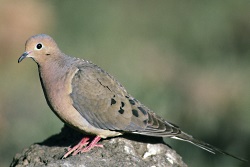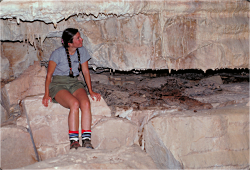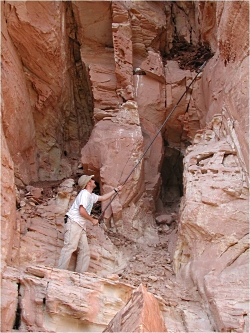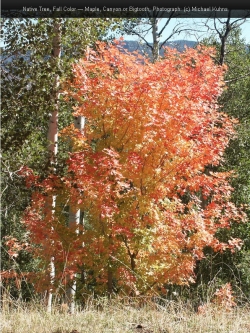
Note the black collar
and the broad square tail
Courtesy Stephen Peterson
 Native Mourning Dove
Native Mourning Dove
Courtesy USFWSDuring the winter after most doves have migrated, you may notice a dove foraging along the roadside or perched in a tree. A new species has arrived in our neighborhood, the Eurasian collared dove or Streptopelia decaocto, which has a distinctive black neck ring and a broad tail.
Originally found near the Bay of Bengal in Asia, this dove began its range expansion in the 1600’s. By 1900, it had made its way to Turkey, and by 2000 could be found as far north as the Arctic Circle in Scandinavia. Expansion into North America occurred in the early seventies when the collared dove appeared in the Bahamas. Since 1982, when first discovered in Florida, it has been gradually making its way north and west. Nineteen ninety-seven marked the first official report of Eurasian collared doves in Orem, Utah. Now they have spread throughout the state.
Eurasian collared doves join rock pigeons, the English sparrow, and the European starling as non-native birds that have expanded across the country. Experts attribute the success of Eurasian collared doves to the wide availability of seed offered by backyard bird feeders, as well as their ability to aggressively defend feeding areas. Some fear that they will cause territory or breeding problems for our native mourning dove, but so far there is no evidence to support this concern.
In an effort to reduce the number of Eurasian collared doves, the Utah DWR allows year-round harvesting. But be careful: don’t confuse this dove with the smaller mourning dove, which has a narrow, pointed tail and no ring on its neck. Eurasian collared doves have a distinct neck band and a broad, squared tail. Their calls also differ.
The mourning dove has the familiar melodic call:
[coo-ah cooo cooo coo]
[Kevin Colver, Songbirds of the Rocky Mountains
12 Mourning Dove]
Now listen to the Eurasian collared dove:
[“coo-coooo-coo”, “coo-coooo-coo”, “coo-coooo-coo”, “krreair”]
[Eurasian collared dove – From Kevin Colver’s private library
Two calls combined for this piece.]
The verdict is still out on the impact that the Eurasian collared dove will have on native species. In the mean time, let’s watch to see how this new dove adapts to the neighborhood and fits into the ecosystem.
Thank-you to Lyle Bingham of Bridgerland Audubon for writing this essay and to Kevin Colver for providing the recorded songs.
This is Linda Kervin for Bridgerland Audubon Society.
Credits:
Photos: Courtesy US Fish & Wildlife Service (USFWS) and Stephen Peterson, Bridgerland Audubon
Recordings: Kevin Colver, https://wildstore.wildsanctuary.com/collections/special-collections
Voice: Linda Kervin, Bridgerland Audubon
Text: Lyle Bingham, Bridgerland Audubon
Additional Reading:
—
Florida’s Introduced Birds: Eurasian collared-Dove (Streptopelia decaocto), Stephen A. Johnson and Gay Donaldson-Fortier, University of Florida IFAS Extension, WEC 256,https://edis.ifas.ufl.edu/pdffiles/UW/UW30100.pdf —
Johnson, S.A. and *G. Donaldson-Fortier. 2009. Florida’s introduced birds: The Eurasian CollaredDove (Streptopelia decaocto). Florida Cooperative Extension Service Publication WEC 256 https://journals.flvc.org/edis/article/download/117916/115917
Tricky Bird IDs: Eurasian Collared-Dove and African Collared-Dove, Project FeederWatch, A Joint Project of the Cornell Lab of Ornithology and Bird Studies Canada, https://www.birds.cornell.edu/pfw/AboutBirdsandFeeding/EucdovRitdovID.htm
Romagosa, Christina Margarita. 2002. Eurasian Collared-Dove (Streptopelia decaocto), The Birds of North America Online (A. Poole, Ed.). Ithaca: Cornell Lab of Ornithology; Retrieved from the Birds of North America Online: https://bna.birds.cornell.edu/bna/species/630/articles/introduction
2009-2010 Upland Game Guidebook, Utah Division of Wildlife Resources, https://wildlife.utah.gov/guidebooks/2009-10_upland_game/2009-10_upland_game.pdf
Complete Birds of North America, ed. Jonathan Alderfer, National Geographic, 2006
Know Your Doves, Texas Parks & Wildlife Department, State of Texas, https://tpwd.texas.gov/education/hunter-education/know-your-doves








